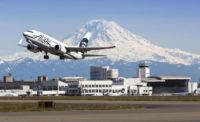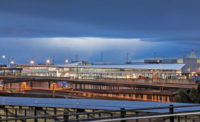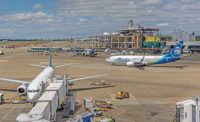Construction projects at Seattle-Tacoma International Airport continue to fly along. Amidst multiple efforts to upgrade nearly every facet of the airport—from ticketing areas to baggage conveyors and concourses to a new International Arrivals Facility—the latest project focuses on a $1.5 billion effort to modernize the S Concourse.
AECOM has been selected to lead the work at the seven-level, 350,000-sq-ft project. On July 21, a contract value of $35 million from the Port of Seattle was executed to lead program management on the project, currently in the design phase. The contract value will get updated once design is 60% complete, as funding for the project comes from commission approvals along the way.
Constructed in the early 1970s and long known as South Satellite, the airport’s main hub for international travelers hasn’t seen any updates since the 1980s. The Port of Seattle says the project will modernize and renovate the facility with enhanced structural and seismic systems to last an additional 50 years.
Named the S Concourse Evolution project, the effort includes modernizing building systems for operational and environmental efficiencies, adding earthquake resiliency that prioritizes seismic updates, design and amenities focused on comfort and additional space for restaurants, shops and lounges.
“SEA has been one of the fastest growing airports for a decade, mirroring the growth happening in the region,” Lance Lyttle, SEA managing director, says in a statement. “During peak periods our terminal is stretched to its max, making it a challenge to deliver the efficient, predictable experience that passengers deserve. To hit our efficiency and customer service goals we need to build up, modernize where we can and introduce new technology.”
AECOM will oversee design and engineering, working with design partner HOK on a combination of renovation and new construction. Jacobs was selected to offer project management services for the S Concourse project. The firm will focus on project controls, estimating and scheduling and advisory services.
Keith Hui, HOK’s regional leader for Aviation + Transportation, says the design strategy features the use of daylight, openness and creating a “unique sense of place.” The goal, he says, is to reduce stress on the traveler while creating a space that is intuitive to navigate.
Specific projects include redevelopment of the recently vacated Federal Inspection Services and Customs and Border Protection spaces no longer needed thanks to the new International Arrivals Facility into a duty-free shopping, dining and retail experience along with the reconfiguration of the concourse level for more efficient circulation. An expansion of the penthouse level will provide additional premium lounge space and upgraded structural systems through the addition of new gate pods.
Currently still early in the design phase, about 15% complete, construction authorization is scheduled for 2023 and the multi-phase timeline has an estimated completion in 2031.
In July, four teams were shortlisted for the general contractor on the project: Hensel Phelps, Hoffman Skanska Joint Venture, PCL Construction Services and Turner Walsh Partners.
Along with recent projects in the Central Terminal, N Concourse and IAF that created or modernized 1 million sq ft at the airport, plenty of projects remain at the property. A $4.6 billion capital investment in the 2023-2027 budget encompasses a swath of improvement including a $546 million SEA Gateway Project to modernize the check-in, ticketing and security checkpoints on the north end of the terminal and a Concourse A extension featuring new lounge space, a Baggage Optimization project updating nearly 10 miles of conveyor belts.
HOK is the designer of the SEA Gateway Project and also was part of the Concourse D Annex, which opened in 2018.






Post a comment to this article
Report Abusive Comment